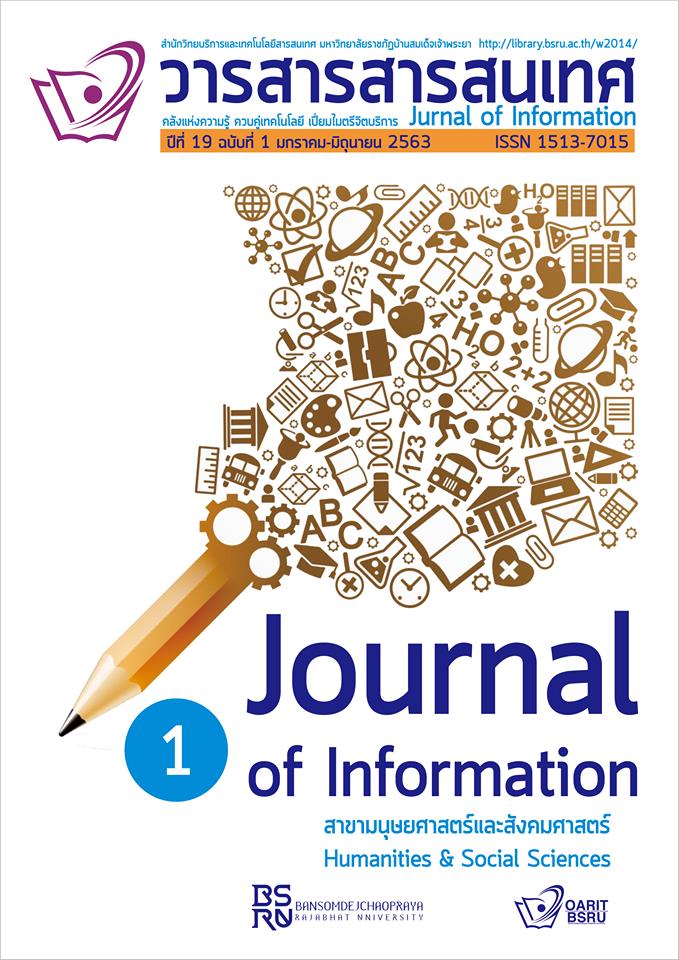The Use of Scaffolding to Enhance Interactional Competence in the EFL Speaking Classroom
Keywords:
Scaffolding, Interactional competence, EFL speaking classroomAbstract
This article reports the improvement of students’ interactional competence with the use of scaffolding interventionand Walsh (2012) Classroom Interactional Competence (CIC) to strengthen interactional competence of Thai students in the EFL speaking classroom. Thirty eight of third year English major students at Chandrakasem Rajabhat University were asked to participate in group discussion of 5 to 6 people. The research instruments of this study were consent form, the holistic scale of oral competence, the CIC template, teacher journal, and video recording of students’ group discussion. Before collecting the data, all participants were asked to sign the consent form as the evidence that they were willing to participate in this research.The prior speaking test was also given to all participants to identify their speaking ability. The assessment could help the researcher create suitable groups, where a mixed-level of participants’ speaking ability combined so the more capable ones can assist the weaker ones to achieve the communicative goals. The prior assessment was established by the researcher before the actual research started. Each participant was asked to interact with the researcher for five minutes in one topic and the audio of discussions were recorded. The holistic scale of oral competence was used to analyze the participants’ speaking ability.After, the researcher and the expert reviewed the findings together and sorted participants into three levels (high, medium, or low speaking competency) based on their speaking performance.To analyze the main findings, the classroom interactional competence (CIC) template was used as the main instrument. Both researcher and the inter-rater used the CIC template to analyze the development of participants’ interactional competence in this study. The teacher journal, and video recording of students’ group discussion were also used to expand the findings in this research. All research instruments and the scaffolding framework were validated by the three experts before collecting the data. The study revealed that scaffolding stimulated the participants to work in groups and help each other to achieve the outcome. Moreover, it offered rooms for participants to discuss and share ideas intrinsically and more productively.
References
Canale, M. & Swain, M. (1980). Theoretical bases of communicative approaches to second language teaching and testing. Applied Linguistics, 1(1), 1-47
Clark, K. & Graves, M., (2005, March). Scaffolding students’ comprehension of text.
The Reading Teacher, 58(6), 570-580
Galaczi, E. D. (2013, November). Interactional competence across proficiency levels: How do learners manage interaction in paired speaking test. Applied Linguistics, 35(5), 553-574. https://www.researchgate.net/publication/274178758_
Interactional_Competence_across_Proficiency_Levels_How_do_
Learners_Manage_Interaction_in_Paired_Speaking_Tests
Kramsch, C. (1986, Winter). From Language Proficiency to Interactional Competence. The Modern Language Journal, 70(4), 366-372. https://onlinelibrary.wiley.com/doi/abs/
10.1111/j.1540-4781.1986.tb05291.x
Hymes, D. H. (1972). On communicative competence. In Pride, J.B. & Holmes, J. (Eds), Sociolinguistics (pp.269-293). Harmondworth, Penguin.
Riley, P. (1996). Developmental sociolinguistics and the competence/performance distinction. In Brown, G., Malmkjxr K. & Williams, J. (Eds), Performance and Competence in Second Language Acquisition (pp.114-135). Great Britain, Cambridge University Press.
Tecedor, M. (2016, Spring). Beginning Learners’ Development of Interactional Competence: Alignment Activity. American Council on the Teaching of Foreign Languages, 49, 23-41. https://www.researchgate.net/publication/294283571
_Beginning_Learners'_Development_of_Interactional
_Competence_Alignment_Activity
Walsh, S. (2012). Conceptualizing classroom interactional competence. Research on Youth and Language, 6(1), 1-14
Young, R. F. (2013). Learning to talk the talk and walk the walk: Interactional competence in academic spoken English. Iberica,25, 15-38.
Downloads
Published
How to Cite
Issue
Section
License
บทความ ข้อความ ภาพประกอบ และตารางประกอบที่ลงพิมพ์ในวารสารเป็นความคิดเห็นส่วนตัวของผู้นิพนธ์ กองบรรณาธิการไม่จำเป็นต้องเห็นตามเสมอไป และไม่มีส่วนรับผิดชอบใดๆ ถือเป็นความรับผิดชอบของผู้นิพนธ์เพียงผู้เดียว






